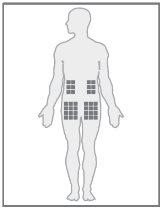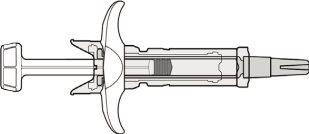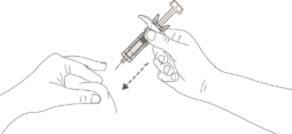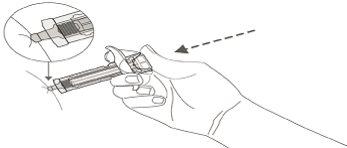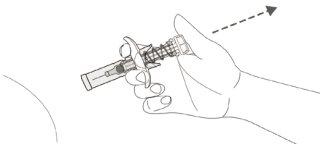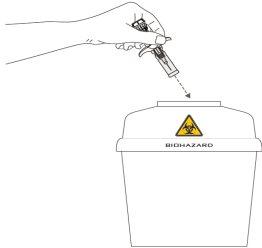
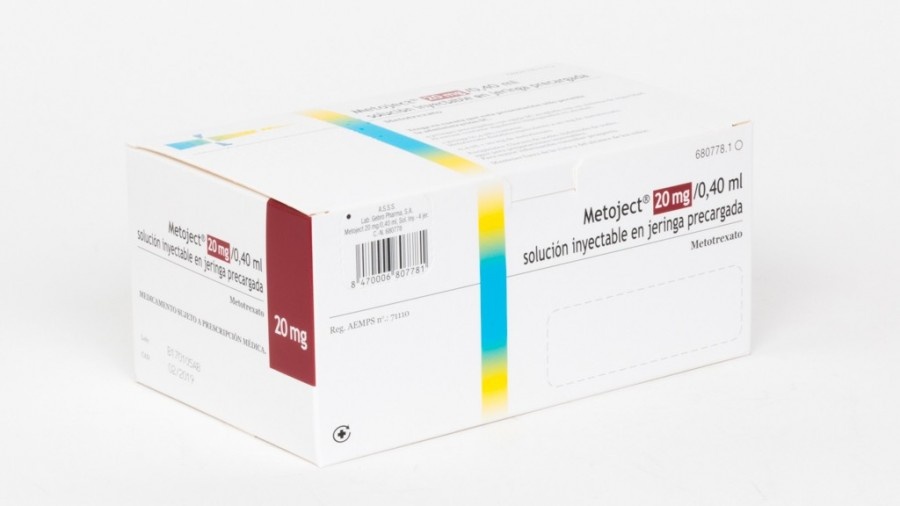
МЕТОФИЛЛ 20 мг/0,40 мл Раствор для инъекций в предварительно заполненном шприце


Инструкция по применению МЕТОФИЛЛ 20 мг/0,40 мл Раствор для инъекций в предварительно заполненном шприце
Введение
Прошу: информация для пользователя
Methofill 20 мг/0,40 мл раствор для инъекций в предварительно заполненном шприце EFG
Метотрексат
Прочитайте весь листок внимательно перед началом использования лекарства, поскольку он содержит важную информацию для вас.
- Сохраните этот листок, поскольку вам может понадобиться перечитать его.
- Если у вас есть какие-либо сомнения, проконсультируйтесь с вашим врачом или фармацевтом.
- Это лекарство было назначено только вам и не должно быть передано другим людям, даже если они имеют те же симптомы, что и вы, поскольку оно может нанести им вред.
- Если вы испытываете побочные эффекты, проконсультируйтесь с вашим врачом или фармацевтом, даже если это побочные эффекты, которые не указаны в этом листке. См. раздел 4.
Содержание листка
- Что такое Methofill и для чего он используется
- Что вам нужно знать перед началом использования Methofill
- Как использовать Methofill
- Возможные побочные эффекты
- Хранение Methofill
- Содержание упаковки и дополнительная информация
1. Что такое Methofill и для чего он используется
Methofill содержит метотрексат в качестве активного вещества.
Метотрексат - это вещество с следующими свойствами:
- он вмешивается в рост определенных клеток организма, которые быстро размножаются,
- он снижает активность иммунной системы (механизма защиты организма),
- он имеет противовоспалительные эффекты.
Methofill показан для лечения:
- активной ревматоидной артриты у взрослых пациентов,
- полиартритных форм ювенильного идиопатического артрита у детей и подростков, когда ответ на нестероидные противовоспалительные препараты (НПВП) неадекватен,
- тяжелой, рецидивирующей и инвалидизирующей псориаз, который не реагирует адекватно на другие методы лечения, такие как фототерапия, ПУВА и ретиноиды, и псориатический артрит у взрослых пациентов,
- легкой и умеренной степени болезни Крона у взрослых пациентов, когда не возможно адекватное лечение другими препаратами.
Ревматоидный артрит (РА) - это хроническое заболевание соединительной ткани, характеризующееся воспалением синовиальных оболочек (оболочек суставов). Эти оболочки производят жидкость, которая действует как смазка во многих суставах. Воспаление приводит к утолщению оболочки и отеку сустава.
Ювенильный артрит поражает детей и подростков в возрасте до 16 лет. Полиартритные формы указаны, если есть поражение 5 или более суставов в первые 6 месяцев заболевания.
Псориатический артрит - это тип артрита с псориатическими поражениями кожи и ногтей, особенно в суставах пальцев рук и ног.
Псориаз - это хроническое и частое заболевание кожи, характеризующееся красными пятнами, покрытыми толстыми, сухими, серебристыми и прилипшими чешуйками.
Methofill изменяет и замедляет течение заболевания.
Болезнь Крона - это тип воспалительного заболевания кишечника, которое может поражать любую часть желудочно-кишечного тракта, вызывая симптомы, такие как боли в животе, диарея, рвота или потеря веса.
2. Что вам нужно знать перед началом использования Methofill
Не используйте Methofill
- если вы аллергичны к метотрексату или любому другому компоненту этого препарата (перечисленному в разделе 6),
- если у вас есть тяжелое заболевание печени или почек или заболевания крови,
- если вы регулярно принимаете большие количества алкоголя,
- если у вас есть тяжелая инфекция, например, туберкулез, ВИЧ или другие синдромы иммунодефицита,
- если у вас есть язвы во рту, желудочные или кишечные язвы,
- если вы беременны или кормите грудью (см. раздел «Беременность, лактация и фертильность»),
- если вы получаете вакцины, изготовленные из ослабленных микроорганизмов, одновременно.
Предостережения и меры предосторожности
Метотрексат может сделать кожу более чувствительной к солнечному свету. Избегайте интенсивного солнца и не используйте солнечные ванны или ультрафиолетовые лампы без консультации с врачом. Чтобы защитить кожу от интенсивного солнца, носите подходящую одежду или используйте солнцезащитный крем с высоким фактором защиты.
Проконсультируйтесь с вашим врачом или фармацевтом перед началом использования Methofill, если:
- у вас есть пожилой возраст или вы обычно чувствуете себя плохо и слабо,
- у вас есть нарушение функции печени,
- у вас есть проблемы с обезвоживанием (потерей жидкости).
Особые меры предосторожности для лечения Methofill
Метотрексат временно влияет на производство сперматозоидов и яйцеклеток, что обратимо в большинстве случаев. Метотрексат может вызвать выкидыши и тяжелые врожденные дефекты. Если вы женщина, вы должны избегать беременности, пока принимаете метотрексат, и в течение как минимум 6 месяцев после окончания лечения метотрексатом. Если вы мужчина, вы должны избегать беременности, пока принимаете метотрексат, и в течение как минимум 3 месяцев после окончания лечения. См. также раздел «Беременность, лактация и фертильность».
Рекомендуемые меры предосторожности и тесты:
Даже при низких дозах Methofill могут возникать тяжелые побочные эффекты. Чтобы их обнаружить вовремя, необходимо, чтобы ваш врач проводил анализы и осмотры.
Перед началом лечения Methofill:
Перед началом лечения вам будут проведены анализы крови, чтобы проверить, что у вас достаточно клеток крови, и будут проведены тесты, чтобы проверить функцию печени и наличие гепатита. Кроме того, будет проверена концентрация сывороточного альбумина (белка крови), состояние гепатита (инфекции печени) и функция почек. Врач также может решить провести другие тесты на печень, некоторые из которых могут включать изображения печени, а другие могут требовать взятия небольшой пробы ткани печени для более детального изучения. Ваш врач также проверит, есть ли у вас туберкулез (инфекционное заболевание с небольшими узелками в пораженной ткани) и проведет рентгенографию грудной клетки или тест на функцию легких.
Во время лечения:
Ваш врач будет проводить следующие анализы:
- осмотр полости рта и горла, чтобы обнаружить изменения в слизистой оболочке, такие как воспаление или язвы
- анализ крови с подсчетом клеток крови и измерением уровня метотрексата в сыворотке
- анализ крови, чтобы контролировать функцию печени
- тесты на изображения, чтобы контролировать состояние печени
- взятие небольшой пробы ткани из печени для более детального изучения
- анализ крови, чтобы контролировать функцию почек
- осмотр дыхательной системы и, если необходимо, тест на функцию легких
Очень важно, чтобы вы прошли эти запланированные тесты.
Если результаты каких-либо из этих тестов вызывают беспокойство, ваш врач отрегулирует ваше лечение соответственно.
Были зарегистрированы случаи острой легочной геморрагии у пациентов с основным ревматологическим заболеванием, принимающих метотрексат. Если вы наблюдаете кровь при кашле или отхаркивании, необходимо немедленно обратиться к вашему врачу.
Метотрексат может влиять на иммунную систему и результаты вакцинации. Он также может влиять на результаты иммунологических тестов. Он может усугубить хронические латентные инфекции (например, герпес зостер, туберкулез, гепатит Б или С). Во время лечения Methofill не следует получать вакцины, изготовленные из ослабленных микроорганизмов.
Во время лечения метотрексатом могут возобновиться радиационные дерматиты и солнечные ожоги (реакции памяти). Псориатические поражения могут усиливаться во время ультрафиолетового облучения и одновременного приема метотрексата.
Может произойти увеличение размера лимфатических узлов (лимфома), и в этом случае лечение должно быть прекращено.
Диарея может быть токсическим эффектом Methofill, требующим прекращения лечения. Если у вас диарея, проконсультируйтесь с вашим врачом.
Были зарегистрированы случаи определенных церебральных расстройств (энцефалопатии/леукоэнцефалопатии) у пациентов с раком, леченных метотрексатом. Не можно исключить возможность возникновения этих побочных эффектов, когда метотрексат используется для лечения других заболеваний.
Если вы, ваш партнер или ваш опекун заметили возникновение или ухудшение неврологических симптомов, таких как мышечная слабость, нарушения зрения, изменения в мышлении, памяти и ориентации, вызывающие путаницу и изменения в личности, немедленно обратитесь к вашему врачу, поскольку это могут быть симптомы редкого и тяжелого церебрального заболевания, называемого прогрессивной мультифокальной лейкоэнцефалопатией (ПМЛ).
Пациенты пожилого возраста
Пациенты пожилого возраста, получающие метотрексат, должны быть внимательно наблюдаемы врачом, чтобы как можно раньше обнаружить возможные побочные эффекты.
Связанное с возрастом ухудшение функции печени и почек, а также низкие резервы фолевой кислоты в организме в пожилом возрасте требуют относительно низкой дозы метотрексата.
Другие лекарства и Methofill
Сообщите вашему врачу или фармацевту, если вы используете, недавно использовали или можете использовать любое другое лекарство. Имейте это в виду также для лекарств, которые вы можете принимать в будущем.
Эффект лечения может быть затронут, если Methofill принимается одновременно с определенными лекарствами:
- Антибиотики, такие как тетрациклины, хлорамфеникол, неабсорбируемые антибиотики широкого спектра, пенициллины, глюкопептиды, сульфонамиды, ципрофлоксацин и цефалотин (лекарства для предотвращения или лечения определенных инфекций).
- Амоксициллин(пенициллины могут снижать выведение метотрексата, что может привести к потенциальному увеличению побочных эффектов).
- Нестероидные противовоспалительные препаратыили салицилаты(лекарства для боли или воспаления, такие как ацетилсалициловая кислота, диклофенак и ибупрофен или пиразолоны)
- Пробенецид(лекарство для подагры).
- Слабые органические кислоты, такие как диуретикипетлевого действия
- Лекарства, которые могут вызывать побочные эффекты в костном мозге, например триметоприм-сульфаметоксазол (антибиотик) и пираметамин
- Другие лекарства, используемые для лечения ревматоидного артрита, такие как лефлуномид, сульфасалазин и азатиоприн.
- Меркаптопурин (цитостатик).
- Ретиноиды (лекарства для псориаза и других дерматологических заболеваний)
- Теофиллин (лекарство для бронхиальной астмы и других легочных заболеваний)
- Некоторые лекарства для желудочно-кишечных расстройств, такие как омепразол и пантопразол.
- Гипогликемические препараты (лекарства, используемые для снижения уровня сахара в крови).
- Метамизол (синонимы новаминсульфон и дипирон)(лекарство для сильной боли и/или лихорадки);
Витамины, содержащие фолиевую кислоту, могут изменить эффект вашего лечения и должны приниматься только по рекомендации вашего врача.
Необходимо избегать вакцинации вакцинами, изготовленными из ослабленных микроорганизмов.
Использование Methofillс продуктами питания, напитками и алкоголем
Во время лечения Methofill необходимо избегать потребления алкоголя и больших количеств кофе, газированных напитков, содержащих кофеин, и черного чая.
Беременность, лактация и фертильность
Беременность
Не используйте Methofill во время беременности или если вы пытаетесь забеременеть. Метотрексат может вызвать врожденные дефекты, повредить плоду или привести к выкидышам. Он ассоциируется с аномалиями развития черепа, лица, сердца и сосудов, мозга и конечностей. Поэтому очень важно, чтобы метотрексат не назначался беременным женщинам или женщинам, планирующим беременность. У женщин детородного возраста необходимо исключить любую возможность беременности с помощью соответствующих мер, например, теста на беременность перед началом лечения. Вы должны избегать беременности, пока принимаете метотрексат, и в течение как минимум 6 месяцев после окончания лечения, используя для этого надежные методы контрацепции в течение всего этого времени (см. также раздел «Предостережения и меры предосторожности»).
Если вы забеременели во время лечения или подозреваете, что могли забеременеть, немедленно обратитесь к вашему врачу. Вам будет предоставлена информация о риске вредного воздействия на ребенка во время лечения.
Если вы хотите забеременеть, проконсультируйтесь с вашим врачом, который может направить вас к специалисту для консультации перед началом планируемого лечения.
Лактация
Прекратите грудное вскармливание до и во время лечения Methofill.
Мужская фертильность
Доступные данные не указывают на повышенный риск врожденных дефектов или выкидышей, если отец принимает дозу метотрексата менее 30 мг/неделю. Однако не можно полностью исключить этот риск. Метотрексат может быть генотоксичным, то есть вызывать генетические мутации. Метотрексат может влиять на производство сперматозоидов и вызывать врожденные дефекты. Поэтому вы должны избегать зачатия ребенка или донорства спермы, пока принимаете метотрексат, и в течение как минимум 3 месяцев после окончания лечения.
Вождение и использование машин
Лечение Methofill может вызывать побочные эффекты, влияющие на центральную нервную систему, такие как усталость и головокружение. Поэтому способность управлять транспортными средствами или использовать машины может быть затронута в некоторых случаях. Если вы чувствуете усталость или сонливость, не должны управлять транспортными средствами или использовать машины.
Methofillсодержит натрий
Это лекарство содержит менее 23 мг натрия (1 ммоль) на дозу; это означает, что оно практически «не содержит натрия».
3. Как использовать Methofill
Следуйте точно инструкциям по применению этого лекарства, указанным вашим врачом. В случае сомнений проконсультируйтесь с вашим врачом или фармацевтом.
Ваш врач определит дозу, которая будет отрегулирована индивидуально. Обычно лечение длится от 4 до 8 недель.
Инъекция Methofill будет введена или контролироваться вашим врачом или медицинским специалистом только один раз в неделю. Вместе с вашим врачом вы выберете день недели, который вам подходит для получения инъекции. Methofill можно вводить подкожно (под кожу).
В начале лечения Methofill может быть введен медицинским персоналом. Однако ваш врач может решить, что вы можете научиться вводить Methofill самостоятельно. Вы получите соответствующую подготовку для этого. В никаких обстоятельствах не должны пытаться вводить Methofill самостоятельно, если вам не было показано, как это делать.
Важное предупреждение о дозе Methofill (метотрексат): Используйте Methofill только один раз в неделю для лечения ревматоидного артрита, ювенильного идиопатического артрита, псориаза и болезни Крона. Чрезмерное использование Methofill (метотрексата) может быть смертельным. Прочитайте раздел 3 этого листка внимательно. Если у вас есть какие-либо сомнения, проконсультируйтесь с вашим врачом или фармацевтом перед приемом этого лекарства. |
Использование у детей и подростков
Поскольку данные об внутривенном введении препарата у детей и подростков очень ограничены, он должен вводиться только подкожно (под кожу).
Врач решает, какая доза подходит для детей и подростков с полиартритными формами ювенильного идиопатического артрита.
Methofill не рекомендуется для использования у детей младше 3 лет из-за ограниченного опыта в этой возрастной группе.
Продолжительность и способ введения
Methofill вводится один раз в неделю.
Врач, ответственный за лечение, решает продолжительность лечения. Лечение ревматоидного артрита, ювенильного идиопатического артрита, псориаза, псориатического артрита и болезни Крона Methofill является долгосрочным лечением.
В начале лечения Methofill может быть введен медицинским персоналом. В некоторых случаях ваш врач может решить научить вас, как вводить Methofill самостоятельно под кожу. Если да, вы получите соответствующую подготовку.
В никаких обстоятельствах не должны пытаться вводить Methofill самостоятельно, прежде чем не получите соответствующую подготовку.
Прочитайте инструкции по применению в конце листка.
Способ обращения и утилизации продукта будет осуществляться в соответствии с руководствами для других цитотоксических препаратов в соответствии с местными правилами. Беременный медицинский персонал не должен обращаться и вводить Methofill.
Метотрексат не должен вступать в контакт с кожей или слизистыми оболочками. Если он вступает в контакт, необходимо немедленно промыть пораженную область большим количеством воды.
Если вы примете больше Methofill, чем необходимо
Если вы примете больше Methofill, чем необходимо, немедленно обратитесь к вашему врачу.
Если вы пропустите прием Methofill
Не принимайте двойную дозу, чтобы компенсировать пропущенные дозы.
Если вы прекратите лечение Methofill
Если вы прекратите лечение Methofill, немедленно обратитесь к вашему врачу.
Если вы считаете, что эффект Methofill слишком сильный или слишком слабый, проконсультируйтесь с вашим врачом или фармацевтом.
В случае передозировки или случайного приема немедленно обратитесь к вашему врачу или фармацевту или позвоните в Центр токсикологической информации, телефон: 91 562 04 20.
4. Возможные побочные эффекты
Как и все лекарства, это лекарство может вызывать побочные эффекты, хотя не все люди испытывают их.
Частота и степень тяжести побочных эффектов будут зависеть от дозы и частоты введения. Важно, чтобы ваш врач проводил периодические проверки, поскольку могут возникнуть серьезные побочные эффекты даже при самых низких дозах. Ваш врач будет проводить тесты для контроля аномалийв крови (таких как низкий уровень лейкоцитов, низкий уровень тромбоцитов и лимфома) и изменения в почках и печени.
Сообщите вашему врачу немедленно, если вы испытываете любой из следующих симптомов, поскольку они могут указывать на серьезный побочный эффект или потенциально опасную для жизни ситуацию, требующую срочного специального лечения:
- Сухой кашель, без мокроты, затруднение дыхания и лихорадка;могут быть признаками воспаления легких [часто]
- Кровь при кашле или отхаркивании;могут быть признаками легочного кровотечения [частота неизвестна]
- Симптомы повреждения печени, такие как желтушная окраска кожи или глаз;метотрексат может вызывать хроническую печеночную недостаточность (цирроз), образование рубцовой ткани в печени (печеночная фиброз), жировую дегенерацию печени [все редко], острую печеночную недостаточность (острый гепатит) [редко] и печеночную недостаточность [очень редко]
- Симптомы аллергии, такие как кожная сыпь, включая зуд и покраснение кожи, отек рук, ног, лодыжек, лица, губ, рта и горла (который может вызвать затруднение глотания или дыхания) и чувство обморока;эти могут быть признаками тяжелых аллергических реакций или анафилактического шока [редко]
- Симптомы повреждения почек, такие как отек рук, ног или лица или изменения в частоте мочеиспускания или уменьшение (олигурия) или отсутствие (анурия) мочи;эти могут быть признаками почечной недостаточности [редко]
- Симптомы инфекции, например лихорадка, озноб, мышечные боли, боль в горле;метотрексат может сделать вас более восприимчивым к инфекциям. Могут возникнуть тяжелые инфекции, такие как某些 типы пневмонии (пневмония, вызванная Pneumocystis jirovecii) или сепсис [редко]
- Симптомы, такие как слабость одной стороны тела (инсульт) или боль, отек, покраснение и необычное тепло в одной из ног (глубокий венозный тромбоз);это может произойти, когда оторвавшийся血яной сгусток вызывает блокировку кровеносного сосуда (тромбоэмболическое событие) [редко]
- Лихорадка и сильное ухудшение общего состояния, или внезапная лихорадка, сопровождаемая болью в горле или рту, или мочевыми проблемами;метотрексат может вызывать внезапное снижение количества определенных белых кровяных клеток (агранулоцитоз) и тяжелую миелосупрессию [очень редко].
- Непредвиденное кровотечение, например кровоточащие десны, кровь в моче, рвота с кровью или синяки;эти могут быть признаками сильного снижения количества тромбоцитов, вызванного тяжелыми эпизодами подавления костного мозга [очень редко]
- Симптомы, такие как сильная головная боль, часто в сочетании с лихорадкой, жесткой шеей, тошнотой, рвотой, дезориентацией и чувствительностью к свету;могут указывать на воспаление оболочек мозга (острый асептический менингит) [очень редко]
- были зарегистрированы определенные расстройства мозга (энцефалопатия/леукоэнцефалопатия) у пациентов с раком, леченных метотрексатом; эти побочные эффекты не могут быть исключены, когда лечение метотрексатом используется для лечения других заболеваний; признаки этого типа расстройств мозга могут быть изменением психического состояния, расстройствами движения (атаксией), зрительными расстройствами или расстройствами памяти;[частота неизвестна]
Тяжелая кожная сыпь или появление пузырей на коже (это также может повлиять на рот, глаза и гениталии);эти могут быть признаками состояния, называемого синдромом Стивенса-Джонсона или токсическим эпидермальным некролизом (синдром Лайелла) [очень редко]
Ниже вы можете найти другие побочные эффекты, которые могут возникнуть:
Очень часто:могут повлиять более 1 из 10 человек
- Воспаление слизистой оболочки рта, изжога, тошнота, потеря аппетита, боли в животе.
- Аномальные результаты тестов функции печени (АСАТ, АЛАТ, билирубин, щелочная фосфатаза).
Часто:могут повлиять до 1 из 10 человек
- Язвы во рту, диарея.
- Сыпь, покраснение кожи, зуд.
- Головные боли, усталость, сонливость.
- Снижение образования кровяных клеток с уменьшением количества белых кровяных клеток, красных кровяных клеток или тромбоцитов.
Редко:могут повлиять до 1 из 100 человек
- Воспаление горла.
- Воспаление кишечника, рвота, воспаление поджелудочной железы, черные или дегтеобразные стул, язвы желудочно-кишечного тракта и кровотечение.
- Реакции, подобные солнечным ожогам, из-за повышенной чувствительности кожи к солнечному свету, выпадение волос, увеличение количества ревматических узлов, кожные язвы, опоясывающий герпес, воспаление кровеносных сосудов, герпетиформная сыпь, крапивница.
- Развитие сахарного диабета.
- Головокружение, дезориентация, депрессия.
- Снижение сывороточного альбумина.
- Снижение количества всех кровяных клеток и тромбоцитов.
- Воспаление и язвы мочевого пузыря или влагалища, снижение функции почек, мочевые расстройства.
- Боли в суставах, мышечные боли, уменьшение костной массы.
Очень редко:могут повлиять до 1 из 1000 человек
- Воспаление десен.
- Увеличение пигментации кожи, акне, синяки на коже, вызванные кровотечением из кровеносных сосудов (экхимоз, петехии), аллергическое воспаление кровеносных сосудов.
- Снижение количества антител в крови.
- Инфекция (включая реактивацию хронических неактивных инфекций), покраснение глаз (конъюнктивит).
- Изменения настроения (настроенческие расстройства).
- Зрительные расстройства.
- Воспаление оболочки, окружающей сердце, накопление жидкости в оболочке, окружающей сердце, блокировка сердечного наполнения из-за наличия жидкости в оболочке, окружающей сердце.
- Низкое кровяное давление.
- Образование рубцовой ткани в легких (легочная фиброз), затруднение дыхания и бронхиальная астма, накопление жидкости в оболочке, окружающей легкие.
- Стрессовая перелом.
- Нарушения электролитного баланса.
- Лихорадка, нарушения заживления ран.
Очень редко:могут повлиять до 1 из 10 000 человек
- Токсическое расширение и острое воспаление кишечника (токсический мегаколон).
- Увеличение пигментации ногтей, воспаление кутикул (острый паракератоз), глубокая инфекция волосяных фолликулов (фурункулез), видимое увеличение мелких кровеносных сосудов.
- Местные повреждения в месте введения (образование стерильных абсцессов, изменения жировой ткани) после инъекции в мышцу или под кожу.
- Боль, потеря силы или онемение/чувствительность к стимулам ниже нормы, нарушения вкуса (металлический вкус), судороги, паралич, менингизм.
- Нарушения зрения, неинфекционные расстройства глаз (ретинопатия).
- Потеря полового влечения, импотенция, увеличение мужской груди, изменение спермы (олигоспермия), нарушения менструального цикла, вагинальные выделения.
- Увеличение размера лимфатических узлов (лимфома).
- Лимфопролиферативные расстройства (чрезмерное увеличение белых кровяных клеток).
Частота неизвестна:не может быть оценена из доступных данных
- Увеличение количества определенных белых кровяных клеток.
- Носовое кровотечение.
- Белки в моче.
- Чувство слабости.
- Повреждение костей челюсти (вторичное по отношению к чрезмерному увеличению белых кровяных клеток).
- Разрушение ткани в месте инъекции.
- Покраснение и шелушение кожи.
- Отек.
При введении метотрексата внутримышечно могут возникать местные побочные реакции (чувство жжения) или повреждения (образование стерильных абсцессов, разрушение жировой ткани) в месте введения. Подкожное введение метотрексата обычно хорошо переносится местно. Были обнаружены только легкие местные кожные реакции, которые уменьшались во время лечения.
Сообщение о побочных эффектах
Если вы испытываете любой побочный эффект, обратитесь к вашему врачу или фармацевту, даже если это возможные побочные эффекты, которые не перечислены в этом листке-вкладыше. Вы также можете сообщить об этом напрямую через www.notificaRAM.es. Сообщая о побочных эффектах, вы можете внести свой вклад в предоставление более полной информации о безопасности этого лекарства.
5. Хранение Метофилла
Храните это лекарство в недоступном для детей месте.
Храните при температуре ниже 30 °C.
Храните предзаполненные шприцы в наружной упаковке, чтобы защитить их от света.
Не используйте это лекарство после даты истечения срока годности, указанной на упаковке. Дата истечения срока годности - последний день месяца, указанного.
Лекарства не должны выбрасываться в канализацию или мусор. Поместите упаковку и лекарства, которые вам больше не нужны, в пункт сбора SIGRE в аптеке. Спросите вашего фармацевта, как избавиться от упаковки и лекарств, которые вам больше не нужны. Таким образом, вы поможете защитить окружающую среду.
6. Содержимое упаковки и дополнительная информация
Состав Метофилла
- Активное вещество - метотрексат. 1 мл раствора содержит метотрексат дисодиум, соответствующий 50 мг метотрексата.
- Другие компоненты - хлорид натрия, гидроксид натрия, вода для инъекционных препаратов.
Внешний вид продукта и содержимое упаковки
Предзаполненные шприцы Метофилла содержат прозрачный желто-коричневый раствор. Предзаполненные шприцы с защитным устройством для иглы. Упаковка содержит предзаполненный шприц с блистерной упаковкой и ватным шариком, пропитанным алкоголем.
Выпускаются следующие размеры упаковок:
Предзаполненные шприцы, содержащие 0,15 мл, 0,20 мл, 0,25 мл, 0,30 мл, 0,35 мл, 0,40 мл, 0,45 мл, 0,50 мл, 0,55 мл и 0,60 мл инъекционного раствора, доступные в упаковках по 1 или 4 предзаполненных шприца, с иглами для подкожных инъекций, оснащенными жесткими защитными устройствами для иглы и градуированными. Кроме того, предзаполненные шприцы с защитным устройством для иглы поставляются с защитным устройством для иглы.
Возможно, не все размеры упаковок будут выпускаться.
Владелец разрешения на маркетинг и ответственный за производство
Владелец разрешения на маркетинг:
Accord Healthcare S.L.U.
World Trade Center
Moll de Barcelona, s/n
Edifici Est 6ª planta,
08039 Barcelona,
Испания
Ответственный за производство:
Accord Healthcare B.V.
Winthontlaan 200,
Utrecht, 3526KV
Нидерланды
или
Laboratori Fundació DAU
C/ C, 12-14 Pol. Ind. Zona Franca,
Barcelona, España
Местный представитель:
Laboratorios Rubió, S.A.
Industria 29
Polígono Industria Comte de Sert
08755 Castellbisbal
(Barcelona)
Испания
Дата последней ревизии этого листка-вкладыша: Август 2024
Подробная и актуальная информация о этом лекарстве доступна на сайте Испанского агентства по лекарствам и медицинским продуктам (AEMPS) http://www.aemps.es
Инструкции по применению
Внимательно прочитайте инструкции перед началом введения инъекции и всегда используйте рекомендуемую вашим врачом, медсестрой или фармацевтом технику применения.
Если у вас возникли проблемы или вопросы, обратитесь к вашему врачу, медсестре или фармацевту.
Подготовка
Выберите чистую, ровную и хорошо освещенную рабочую поверхность.
Тщательно вымойте руки. Перед использованием проверьте шприц метотрексата на наличие видимых дефектов (или трещин).
Место инъекции
| Лучшие места для инъекции:
|
|
Введение раствора
- Откройте коробку, содержащую предзаполненный шприц метотрексата, и внимательно прочитайте листок-вкладыш. Удалите предзаполненный шприц из упаковки при комнатной температуре.
| Выберите место для инъекции и продезинфицируйте его ватным шариком, пропитанным алкоголем. Подождите 60 секунд, чтобы дезинфицирующее средство высохло. |
| Проверьте целостность системы Не используйте устройство:
Обычно устройство не может быть использовано, если оно не соответствует рисунку слева. Если это так, утилизируйте устройство в контейнере для биологических опасностей (колючих). |
|
|
|
|
| Поместите большой палец на головку поршня; Нажмите на поршень и твердо надавитев конце инъекции, чтобы đảmнить, что шприц полностью опорожнен. Держите кожу в безопасности до тех пор, пока инъекция не будет завершена. |
| Система безопасности будет активирована, когда поршень будет полностью втянут: Держите шприц неподвижным и медленно поднимите большой палец от головки поршня; Поршень переместится вверх с вашим большим пальцем, и пружина втянет иглу из места в защитный колпачок для иглы. |
| Как только шприц был использован, немедленно утилизируйте устройство в контейнере для биологических опасностей (колючих). Не выбрасывайте использованный защитный колпачок для иглы в домашний мусор. |
Метотрексат не должен вступать в контакт с кожей или слизистыми оболочками. В случае загрязнения необходимо немедленно промыть пораженную область большим количеством воды.
Если вы или кто-то из вашего окружения получил травму от иглы, немедленно обратитесь к врачу и не используйте этот предзаполненный шприц.
Утилизация и другие манипуляции
Обращение и утилизация лекарства и предзаполненного шприца будут осуществляться в соответствии с местными правилами. Беременный медицинский персонал не должен обращаться с метотрексатом или вводить его.

Сколько стоит МЕТОФИЛЛ 20 мг/0,40 мл Раствор для инъекций в предварительно заполненном шприце в Испании в 2025 году?
Средняя цена на МЕТОФИЛЛ 20 мг/0,40 мл Раствор для инъекций в предварительно заполненном шприце в декабрь, 2025 года составляет около 26.96 евро. Финальная стоимость может зависеть от региона, конкретной аптеки и рецептурного статуса. Для точной информации лучше проверить онлайн или в ближайшей аптеке.
- Страна регистрации
- Средняя цена в аптеках26.96 EUR
- Активное вещество
- Требуется рецептДа
- Производитель
- Информация носит справочный характер и не является медицинской рекомендацией. Перед приемом любых препаратов проконсультируйтесь с врачом. Oladoctor не несет ответственности за медицинские решения, принятые на основе этого контента.
- Аналоги МЕТОФИЛЛ 20 мг/0,40 мл Раствор для инъекций в предварительно заполненном шприцеФорма выпуска: ИНЪЕКЦИОННЫЙ РАСТВОР, 10 мг/ 1 млАктивное вещество: МетотрексатПроизводитель: Ebewe Pharma Ges.M.B.H. Nfg.KgТребуется рецептФорма выпуска: ИНЪЕКЦИОННЫЙ РАСТВОР, 15 мгАктивное вещество: МетотрексатПроизводитель: Ebewe Pharma Ges.M.B.H. Nfg.KgТребуется рецептФорма выпуска: ИНЪЕКЦИОННЫЙ РАСТВОР, 20 мгАктивное вещество: МетотрексатПроизводитель: Ebewe Pharma Ges.M.B.H. Nfg.KgТребуется рецепт
Аналоги МЕТОФИЛЛ 20 мг/0,40 мл Раствор для инъекций в предварительно заполненном шприце в других странах
Лучшие аналоги с тем же действующим веществом и терапевтическим эффектом.
Аналог МЕТОФИЛЛ 20 мг/0,40 мл Раствор для инъекций в предварительно заполненном шприце в Polska
Аналог МЕТОФИЛЛ 20 мг/0,40 мл Раствор для инъекций в предварительно заполненном шприце в Ukraina
Врачи онлайн по МЕТОФИЛЛ 20 мг/0,40 мл Раствор для инъекций в предварительно заполненном шприце
Консультация по дозировке, побочным эффектам, взаимодействиям, противопоказаниям и продлению рецепта на МЕТОФИЛЛ 20 мг/0,40 мл Раствор для инъекций в предварительно заполненном шприце – по решению врача и с учетом местных правил.



